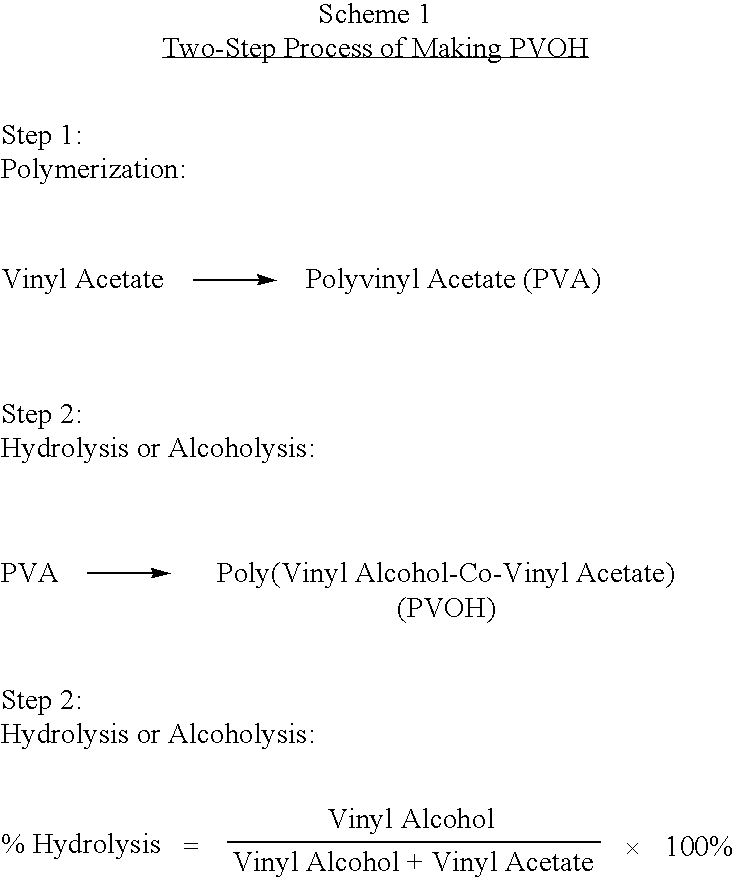Blend compositions of an unmodified poly vinyl alcohol and a thermoplastic elastomer
a technology of thermoplastic elastomer and polyvinyl alcohol, which is applied in the direction of textiles and paper, water-setting substance layered products, synthetic resin layered products, etc., can solve the problems of plasticizer loss, plasticizer addition, and volatile plasticizer fogging, so as to facilitate extrusion and enhance softness and ductility, the effect of less nois
- Summary
- Abstract
- Description
- Claims
- Application Information
AI Technical Summary
Benefits of technology
Problems solved by technology
Method used
Image
Examples
example 1
[0046]The melt processability of PVOH was first demonstrated by a twin-screw extrusion process. A Haake (Paramus, N.J.) TW-100 counter-rotating twin-screw extruder, fitted with a 4″ cast film die was used. The extruder had a length of 300 mm Each conical screw had a diameter of 30 mm at the feed port and a diameter of 20 mm at the die. A grade of relatively low degree hydrolysis from Nippon Gohsei, GOSHENOL® KP-06, was selected. This PVOH resin was manufactured for use as a dispersion agent for use in aqueous solution applications. It was not intended for melt processing. The degree of hydrolysis is 71-74%, it's viscosity in a 4% solution in water at 20° C. is 5 to 7 cp, as measured by Hoeppler failing ball method. It is supplied as a white granulate powder. To test the possibility for thermoplastic process, the resin was fed to the Haake twin-screw extruder directly without pelletization.
[0047]An extruded film was collected by a chilled wind-up roll. Initially, the screw speed was ...
example 2
[0048]In Example 2, the same PVOH resin used in Example 1 was tested to determine whether the film processing conditions could be improved. First, the extrusion temperature profile was modified. The barrel temperatures were set at 150, 185, 185 and 180° C. for zones 1, 2, 3 and 4 (die) respectively. The screw speed was maintained at 134 rpm. This lower die set temperature brought down the melt temperature to about 195 to 200° C. Surprisingly, as the melt temperature of the PVOH dropped, the film properties improved dramatically. At a melt temperature of about 195 to 200° C., the melt strength of PVOH improved greatly such that a PVOH film could be drawn down to less than 0.2 rail. In contrast to the hazy appearance of the PVOH made in Example 1, the PVOH film made in this example under the lower melt temperature had excellent clarity and was essentially free of film defects.
[0049]Compared to the PVOH film in Example 1, the film made at a lower temperature had greater strength and so...
example 3
[0050]The same PVOH resin used in Example 1 was used for this example. PVOH is usually delivered from the manufacture in a powdered form. Since polymers in the pellet form are generally easier to work with, an experiment was devised to see if cast films created directly from PVOH powder had different tensile properties that those created from PVOH in the pellet form. PVOH pellets were made by extruding PVOH powder on a Werner & Pfleiderer (Ramsey, N.J.) ZSK-30 extruder at 20 1b / hr and 300 rpm. The ZSK-30 extruder has a pair of co-rotating screws arranged in parallel with the center-to-center distance between the shafts of the two screws at 26.2 mm. The nominal screw diameters are 30 mm. The actual outer diameters of the screws are 30 mm and the inner screw diameters are 21.3 mm. The thread depths are 4.7 mm. The length of the screws are 1328 mm and the total processing section length was 1338 mm. This ZSK-30 extruder had 14 processing barrels which were numbered consecutively 1 to 1...
PUM
| Property | Measurement | Unit |
|---|---|---|
| viscosity | aaaaa | aaaaa |
| viscosity | aaaaa | aaaaa |
| melt viscosity | aaaaa | aaaaa |
Abstract
Description
Claims
Application Information
 Login to View More
Login to View More - R&D
- Intellectual Property
- Life Sciences
- Materials
- Tech Scout
- Unparalleled Data Quality
- Higher Quality Content
- 60% Fewer Hallucinations
Browse by: Latest US Patents, China's latest patents, Technical Efficacy Thesaurus, Application Domain, Technology Topic, Popular Technical Reports.
© 2025 PatSnap. All rights reserved.Legal|Privacy policy|Modern Slavery Act Transparency Statement|Sitemap|About US| Contact US: help@patsnap.com

